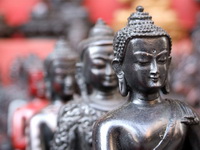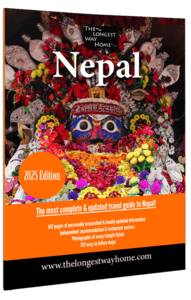

The Essential Guide to Bargaining and Bartering in Nepal: Master the Art of Negotiation
Table of Contents
- Why Bargaining is Essential in Nepal
- Why Tourists Struggle with Bargaining
- Why Thamel Isn’t the Best Place for Bargains
- Best Places to Buy Authentic Souvenirs in Kathmandu
- 7-Step Process to Bargain Like a Local
- Ethical Considerations When Bargaining
- Trying Your Hand at Bartering
- Final Tips for Successful Souvenir Shopping
Why Bargaining is Essential in Nepal
If you’re planning to visit Nepal but feel uncomfortable with haggling, you’ll need to adapt quickly. Unlike countries with fixed pricing, bargaining is deeply embedded in Nepalese culture and is an expected part of nearly every transaction.
This isn’t just a tourist trap either – watch local Nepalis shopping for vegetables at markets they’re unfamiliar with, and you’ll see the same bargaining dance play out. It’s a cultural practice that extends to all aspects of commerce.
Refusing to bargain doesn’t just mean paying more – it actually has social implications. Many locals will perceive non-bargainers as arrogant or naively wealthy. By learning to negotiate prices, you’re showing cultural respect while protecting your travel budget.
Why Tourists Struggle with Bargaining
Understanding Your Position as a Visitor: Tourists unfamiliar with bargaining culture often become easy targets in Nepal’s markets. Many visitors simply accept the first price offered, not realizing that initial quotes are intentionally inflated by 200-300%.
A common mistake is comparing souvenir prices to what similar items might cost back home.

Thamel in Kathmandu perfectly illustrates this dynamic. A tourist spots an intricately carved incense holder, asks the price, and is told “500 rupees – fixed price.”
Most visitors will hand over the rupees without hesitation, believing they’ve encountered a non-negotiable price tag. What they don’t realize is that this “fixed price” claim is simply the opening gambit in an expected negotiation.
The stated price is merely the beginning of a dance both buyer and seller understand – except for uninitiated tourists.
Even travelers who have read about offering half the asking price often retreat when the vendor shakes their head and places the item back on the shelf. They feel they’ve somehow insulted the shopkeeper or lost their chance at purchasing the item.
In reality, this is just the opening move in Nepal’s bargaining culture, and the game has only just begun.
Why Thamel Isn’t the Best Place for Bargains
Location Matters in Bargaining Success: Thamel serves as Kathmandu’s tourist epicenter for souvenir shopping, with countless shops offering everything from singing bowls to prayer wheels. However, this popularity creates a distinct disadvantage for bargain hunters.
Thamel’s high tourist traffic makes it one of the most challenging places to secure good deals through bargaining.
The simple economics explain why: when demand is consistently high and new tourists arrive daily, vendors have little incentive to significantly lower their prices. If you don’t buy at their preferred price point, they know another visitor likely will within hours.
Where to Find Quality Souvenirs in Kathmandu
Your shopping strategy should depend on what you’re seeking. For wholesale purchases, the outskirts of Thamel extending into New Road host numerous suppliers who normally sell in bulk to international markets including Tibet and Thailand. This route works well if you’re looking to purchase large quantities of items like singing bowls.
However, cold-calling these wholesalers isn’t recommended. Nepal’s business culture revolves around personal connections – knowing someone who knows the right supplier can make all the difference.
The Best Place for Tourist Souvenirs in Kathmandu
Understanding Souvenir Shopping: To be clear, we’re discussing tourist-oriented items like singing bowls, prayer wheels, paintings, statues, masks, incense holders, and jewelry. These products are specifically manufactured for visitors, not for everyday Nepali use.
For travelers with limited time who still want quality souvenirs at reasonable prices, I recommend one specific location for your final day of shopping in Kathmandu.
Surprisingly, it’s the major tourist attraction of Kathmandu Durbar Square. Here you’ll find an authentic mini-market of souvenir stalls run by local vendors, primarily set on low tables and blankets spread on the ground near the main ticket office.

Visit early in the morning when vendors are setting up – the first sale of the day is considered auspicious, especially among older sellers, potentially giving you additional bargaining leverage.
How to Bargain Like a Local in Kathmandu: 7-Step Process
Even if you’ve never haggled before, follow this simple step-by-step approach to master the art of bargaining in Nepal:
1) Survey the Market: Begin by simply walking through the market area. Vendors will often call out prices while showing various items. Take mental notes of prices without showing particular interest in anything yet.
2) Price Investigation: When you find something you want (let’s use a prayer wheel as an example), appear casually interested. Either lift the item slightly or simply point to it and ask the price without revealing enthusiasm. Wait patiently for their response.
3) Strategic Movement: Once you hear the price, slightly shake your head and continue walking. Move to another seller who’s preferably out of sight from the first vendor.
4) Comparison Shopping: Point to a similar prayer wheel and request the price. If they quote higher, show genuine surprise and mention it’s cheaper elsewhere. If they ask “how much?” don’t reveal the exact figure – instead, keep pressing them for their best price. If they remain silent, begin walking away. They’ll typically call out a reduced price before you’ve gone far.
5) Calculate Your Target: You now have two reference prices for prayer wheels. Mentally reduce the lower quote by approximately 25% – this becomes your target price.
6) Make Your Offer: Approach a third vendor and inquire about a similar prayer wheel. Ignore their initial price and instead quote your calculated target price (the lowest previous offer minus 25%). Stand firm and mention it would be their “first sale of the day” for good luck. If they agree or counter reasonably, you’ve established a good negotiating position.
7) Expand Your Purchase: Now suggest you might buy multiple items from their stall if they can offer good prices across the board. Either continue with this vendor or return to previous sellers with your newly established baseline price.
Congratulations – you’ve just bargained like an experienced traveler!
Ethical Considerations When Bargaining
Knowing When to Stop
I’ve witnessed travelers applying aggressive Middle Eastern bargaining tactics in Nepal with disastrous results. While negotiation is universal, cultural nuances matter tremendously.
Equally concerning are tourists who push elderly vendors into selling items below cost price. Why would someone sell at a loss? Sometimes desperation for that day’s meal forces difficult decisions.
Maintain perspective during your negotiations. When you feel you’ve secured a fair price, be content with your purchase. Ensure the transaction leaves both parties reasonably satisfied – remember that extreme bargaining can sometimes cross into exploitation.
Trying Your Hand at Bartering
Beyond Price Negotiation: Want to experience authentic cultural exchange? Consider actual bartering – offering items of value instead of just negotiating price. Perhaps you have souvenirs from your own country or small items that might interest vendors.
This practice has deep historical roots – in the 1970s, Western travelers would trade branded jeans for food or accommodation! While Nepal now has plenty of denim, certain foreign items still hold novelty value.
A word of caution: don’t expect bartering everywhere. Today it’s generally done in relaxed, almost playful contexts rather than as serious transactions. Traditional price bargaining remains the more common approach.

Final Tips for Successful Souvenir Shopping in Nepal
The bargaining process might initially feel uncomfortable for those from fixed-price cultures, but the entire exchange typically takes just 10-15 minutes. Remember that bargaining in Nepal demonstrates cultural respect – refusing to negotiate actually marks you as an easy target.
When approached with the right mindset, this practice creates memorable interactions, photo opportunities, and authentic cultural experiences. Most importantly, both you and the vendor understand the dance – you’re simply seeking fair value while they aim for reasonable profit.
Plan at least one dedicated day for souvenir shopping during your Nepal trip. If your itinerary includes Bhaktapur, you’ll find excellent pottery, woodcarvings, paintings, and puppets at prices typically lower than Kathmandu.
Nepal remains one of the world’s premier destinations for unique, handcrafted souvenirs. Embrace the bargaining culture and enjoy the treasure hunt!
For more specific recommendations on what to purchase, check out my detailed guide to the best souvenirs to buy in Kathmandu, Nepal.
This comprehensive guide helps you master the art of bargaining in Nepal’s vibrant markets
Get my Guidebook to Nepal & discover more than anyone else!
Find out more about places like this with the most up-to-date, popular and dedicated guidebook to Nepal in the world. Over 617 pages, 110 maps & 984+ photographs of every temple listed plus photos of every day on all the treks shown, jungle safaris and so much more.
Take a look below and you’ll find out why this beats all other guidebooks!


I don’t mind bargaining, wife hates it. So she shops and I bargain. It’s a good combination aside from the fact it’s my wallet too!
Ha ha, well at least you’ve got a system!
Great tips that really do work. First sale of the day is very important here in Nepal. It signals good fortune for the rest of the day.
First sale beats the last sale of the day everyday
Really helpful tips. I’m terrible at bargaining but this I think could work. I just don’t like the idea of anyone telling me that I’m being too mean.
I’ve never heard of someone being accused of being too mean. Try to the point you are comfortable with
I always like to appeal to people’s lighter side. Adding in a joke or asking about their family.
If there’s no language barrier then that’s a great tip!
Great tips. I never would have asked or known. Is it the same in India?
When I was there I found it a lot more aggressive than in Nepal when it came to bargaining. It could be regional though. But Nepal is pretty non-aggressive when it comes to bartering.
I’m going to try applying this on my next holiday, solid tips on bartering from a pro. Thanks Dave.
You’re welcome Jan, hope the tips work for you!
ahahaha..nice! I love to bargain and my bargain skill is pretty good (ahem). I agree with you, it’s not only about the lower price, it’s about not being stupid :p
I enjoyed your write-ups I am older with a wife who is somewhat younger. I Have thought of living in Nepal I am a master Electrician Retired and wife does medical volunteer work here in Texas. Could we live in a city (Which one?) on 3000 USD per month (No cooking no house work for us)? Suggestions?
I’ll be writing about living in Nepal later this week. If you check back then you’ll get a lot of this information.